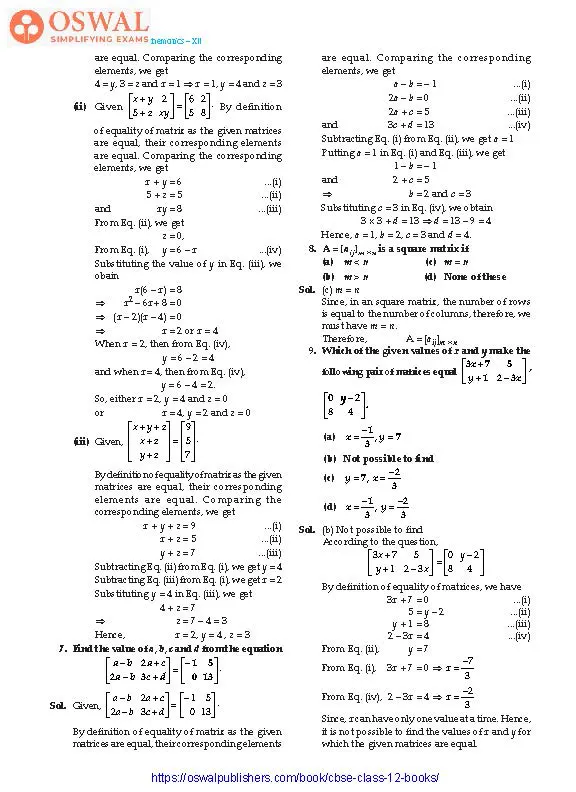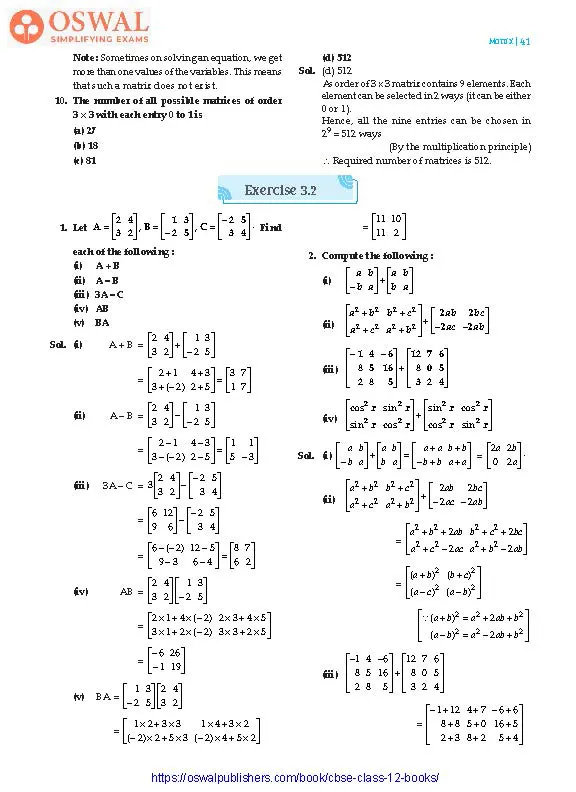NCERT Solutions for Class 12 Maths Chapter 3 Matrix - Exercise 3.1




Access Exercises of Class 12 Maths Chapter 3 – Matrix
Exercise 3.1 Solutions: 10 Questions (7 Short Answers, 3 MCQs)
Exercise 3.2 Solutions: 22 Questions (14 Long, 6 Short, 2 MCQs)
Exercise 3.3 Solutions: 12 Questions (10 Short Answers, 2 MCQs)
Exercise 3.4 Solutions: 18 Questions (4 Long, 13 Short, 1 MCQ)
Miscellaneous Exercise Solutions: 15 Questions (7 Long, 5 Short, 3 MCQs)
Exercise 3.1
1. In the matrix
$$\begin{bmatrix} \textbf{2} &\textbf{5} &\textbf{19} &\textbf{-7}\\ \textbf{35} &\textbf{-2} &\frac{\textbf{5}}{\textbf{2}} &\textbf{12}\\\sqrt{\textbf{3}} &\textbf{1} &\textbf{-5}&\textbf{17}\end{bmatrix},\space\textbf{write :}$$
(i) the order of the matrix
(ii) the number of elements,
(iii) the elements a13, a21, a33, a24, a23.
Sol. (i) In the given matrix, the number of rows is 3 and the number of columns is 4. Therefore, the order of the matrix is 3 × 4.
(ii) Since, the order of the matrix is 3 × 4, so there are are 3 × 4 = 12 elements in it.
$$\begin{bmatrix}2 &5 &19 &-7 \\ 35 &-2 &\frac{5}{2} &12\\\sqrt{3} &1 &-5 &17\end{bmatrix}=\\\begin{bmatrix}a_{11} &a_{12} &a_{13} &a_{14}\\ a_{21} &a_{22} &a_{23} &a_{24}\\ a_{31} &a_{32} &a_{33} &a_{34}\end{bmatrix}$$
On comparing the corresponding elements, we get
$$a_{13} =19; a_{21} = 35; a_{33} =-5;\\a_{24}=12; a_{23} =\frac{5}{2}.$$
2. If a matrix has 24 elements, what are the
possible orders it can have? What, if it has 13 elements?
Sol. We know that if a matrix is of the order m × n, it has mn elements. Hence, a matrix containing 24 elements can have any one of the following orders :
1 × 24, 2 × 12, 3 × 8, 4 × 6, 6 × 4, 8 × 3, 12 × 2 or 24 × 1.
Similarly, a matrix containing 13 elements can have order 1 × 13 or 13 × 1.
3. If a matrix has 18 elements, what are the possible orders it can have? What, if it has 5 elements?
Sol. Since, a matrix containing 18 elements can have any one of the following orders :
1 × 18, 18 × 1, 2 × 9, 9 × 2, 3 × 6, 6 × 3
Similarly, a matrix containing 5 elements can have order 1 ×5 or 5 × 1.
4. Construct 2 × 2 matrix, A = [aij] whose elements are given by
$$\textbf{(i)\space} \textbf{a}_{\textbf{ij}} \textbf{=}\frac{\textbf{(i +j)}^{\textbf{2}}}{\textbf{2}}\\\textbf{(ii)\space} \textbf{a}_{\textbf{ij}} \textbf{=}\frac{\textbf{i}}{\textbf{j}}\\\textbf{(iii)\space}\textbf{a}_{\textbf{ij}} = \frac{\textbf{(i + 2j)}^{\textbf{2}}}{\textbf{2}} $$
Sol. (i) The order of the given matrix is 2 × 2, so,
$$\text{A =}\begin{bmatrix}a_{11} &a_{12} \\a_{21} &a_{22}\end{bmatrix}_{2×2},\\\text{where }a_{ij} = \frac{(i + j)^{2}}{2}.$$
To find a11, put i = 1 and j = 1.
$$\therefore\space a_{11} = \frac{(1 + 1)^{2}}{2}=2\\\text{Similarly,}\\\space a_{12} =\frac{(1 + 2)^{2}}{2} =\frac{9}{2}\\a_{21} =\frac{(2+1)^{2}}{2}=\frac{9}{2}\\\text{and}\space a_{22} =\frac{(2 +2)^{2}}{2} = 8\\\text{Hence, the required matrix is}\\\text{A =}\begin{bmatrix}2 & \frac{9}{2}\\ \frac{9}{2}&8 \end{bmatrix}_{2×2}\\\text{(ii)\space Here,}\space\text{A =}\begin{bmatrix}a_{11} & a_{12} \\a_{21} & a_{22}\end{bmatrix}_{2×2},$$
$$\text{where}\space a_{ij} =\frac{i}{j}.\\\therefore\space a_{11}=\frac{1}{1}=1,a_{12} =\frac{1}{2},\\a_{21}=\frac{2}{1}=2\space\text{and}\space a_{22}=\frac{2}{2}=1$$
Hence, the required matrix is
$$\text{A} =\begin{bmatrix}\frac{9}{2} &\frac{25}{2} \\8 & 18 \end{bmatrix}_{2×2}$$
5. Construct a 3 × 4 matrix whose elements are given by
$$\textbf{(i)\space} \textbf{a}_{\textbf{ij}} \textbf{=} \frac{\textbf{1}}{\textbf{2}}|-3\textbf{i + j}|$$
(ii) aij = 2i – j.
Sol. (i) The order of given matrix is 3 × 4, so the required matrix is
$$\text{A =}\begin{bmatrix}a_{11} &a_{12} &a_{13} &a_{14}\\ a_{21} &a_{22} &a_{23} &a_{24}\\ a_{31} &a_{32} &a_{33} &a_{34}\end{bmatrix}_{3×4}\\\text{where}\space a_{ij} = \frac{1}{2}|-3\text{i +j}|.$$
Putting the values in place of i and j,. we will find all the elements of matrix A.
$$\therefore\space a_{11} = \frac{1}{2}|-3+1|=1\\a_{12} =\frac{1}{2}|-3+2|=\frac{1}{2}\\a_{13} =\frac{1}{2}|-3 +3|=0\\a_{14}=\frac{1}{2}|-3+4| =\frac{1}{2}\\a_{21} =\frac{1}{2}|-6+1| =\frac{5}{2}\\a_{22} =\frac{1}{2}|-6+2|=2\\a_{23} =\frac{1}{2}|-6+3| =\frac{3}{2}\\a_{24} =\frac{1}{2}|-6+4|=1$$
$$a_{31} =\frac{1}{2}|-9+1|=4\\a_{32} =\frac{1}{2}|-9+2|=\frac{7}{2}\\a_{33}=\frac{1}{2}|-9+3|=3\\a_{34} =\frac{1}{2}|-9+4|=\frac{5}{2}$$
Hence, the required matrix is
$$\text{A} =\begin{bmatrix}1 &\frac{1}{2} &0 &\frac{1}{2}\\\frac{5}{2} &2 &\frac{3}{2} &1\\ 4&\frac{7}{2} &3 &\frac{5}{2}\end{bmatrix}_{3×4}\\\text{(ii)\space Here A =}\\\begin{bmatrix}a_{11} &a_{12} &a_{13} &a_{14}\\a_{21} &a_{22} &a_{23} &a_{24}\\ a_{31} &a_{32} &a_{33} &a_{34}\end{bmatrix}_{3×4}$$
where aij = 2i – j
∴ a11 = 2 – 1= 1
a12 = 2 – 2 = 0
a13 = 2 – 3 = – 1
a14 = 2 – 4 = – 2
a21 = 4 – 1 = 3
a22 = 4 – 2 = 2
a23 = 4 – 3 = 1
a24 = 4 – 4 = 0
a31 = 6 – 1 = 5
a32 = 6 – 2 = 4
a33 = 6 – 3 = 3
and a34 = 6 – 4 = 2
Hence, the required matrix is
$$\text{A =}\begin{bmatrix}1 &0 &-1 &-2\\ 3 &2 &1 &0\\ 5 &4 &3 &2\end{bmatrix}_{3×4}$$
6. Find the values of x, y and z from the following equations :
$$\textbf{(i)\space}\begin{bmatrix}\textbf{4} & \textbf{3} \\\textbf{x} & \textbf{5}\end{bmatrix}\textbf{=}\begin{bmatrix}\textbf{y} & \textbf{z} \\\textbf{1} & \textbf{5}\end{bmatrix}\\\textbf{(ii)\space}\begin{bmatrix}\textbf{x+y} & \textbf{2} \\\textbf{5+z} & \textbf{xy} \end{bmatrix}=\begin{bmatrix}\textbf{6} & \textbf{2} \\\textbf{5} & \textbf{8} \end{bmatrix}\\\textbf{(iii)\space}\begin{bmatrix}\textbf{x+y+z} \\\textbf{x+z}\\\textbf{y+z} \end{bmatrix} =\begin{bmatrix} 9\\5\\7\end{bmatrix}\\\textbf{Sol.\space}(i)\space\text{Given,}\space \begin{bmatrix}4 &3\\ x&5\end{bmatrix} =\begin{bmatrix}y & z \\ 1 & 5 \end{bmatrix}.$$
By definition of equality of matrix as the given matrices are equal, their corresponding elements are equal. Comparing the corresponding elements, we get
4 = y, 3 = z and x = 1 ⇒ x = 1, y = 4 and z = 3
$$\text{(ii)\space Given}\begin{bmatrix}x+y &2 \\5+z &xy \end{bmatrix}=\begin{bmatrix}6 & 2 \\5 & 8 \end{bmatrix}.$$
By definition of equality of matrix as the given matrices are equal, their corresponding elements
are equal. Comparing the corresponding elements, we get
x + y = 6 ...(i)
5 + z = 5 ...(ii)
and xy = 8 ...(iii)
From Eq. (ii), we get
z = 0,
From Eq. (i), y = 6 – x ...(iv)
Substituting the value of y in Eq. (iii), we obain
x(6 – x) = 8
⇒ x2 – 6x+ 8 = 0
⇒ (x – 2)(x – 4) = 0
⇒ x = 2 or x = 4
When x = 2, then from Eq. (iv),
y = 6 – 2 = 4
and when x= 4, then from Eq. (iv),
y = 6 – 4 = 2.
So, either x = 2, y = 4 and z = 0
or x = 4, y = 2 and z = 0
$$\text{(iii)\space Given,} \begin{bmatrix}x+y+z\\ x+z\\ y+z\end{bmatrix} =\begin{bmatrix}9\\5\\7\end{bmatrix}.$$
By definition of equality of matrix as the given matrices are equal, their corresponding elements are equal. Comparing the corresponding elements, we get
x + y + z = 9 ...(i)
x + z = 5 ...(ii)
y + z = 7 ...(iii)
Subtracting Eq. (ii) from Eq. (i), we get y = 4
Subtracting Eq. (iii) from Eq. (i), we get x = 2
Substituting y = 4 in Eq. (iii), we get
4 + z = 7
⇒ z = 7 – 4 = 3
Hence, x = 2, y = 4 , z = 3
7. Find the value of a, b, c and d from the equation
$$\begin{bmatrix}\textbf{a-b} &\textbf{2a+c} \\\textbf{2a-b} &\textbf{3c+d}\end{bmatrix} =\begin{bmatrix}\normalsize-\textbf{1} &\textbf{5} \\\textbf{0} &\textbf{13}\end{bmatrix}.\\\textbf{Sol.\space}\text{Given},\\\space\begin{bmatrix}a-b &2a+c \\2a-b &3c+d\end{bmatrix}=\begin{bmatrix}\normalsize-1 &5 \\0 &13 \end{bmatrix}.$$
By definition of equality of matrix as the given matrices are equal, their corresponding elements are equal. Comparing the corresponding elements, we get
a – b = – 1 ...(i)
2a – b = 0 ...(ii)
2a + c = 5 ...(iii)
and 3c + d = 13 ...(iv)
Subtracting Eq. (i) from Eq. (ii), we get a = 1 Putting a = 1 in Eq. (i) and Eq. (iii), we get
1 – b = – 1
and 2 + c = 5
⇒ b = 2 and c = 3
Substituting c = 3 in Eq. (iv), we obtain
3 × 3 + d = 13 ⇒ d = 13 – 9 = 4
Hence, a = 1, b = 2, c = 3 and d = 4.
8. A = [aij]m × n is a square matrix if
(a) m < n
(b) m > n
(c) m = n
(d) None of these
Sol. (c) m = n
Since, in an square matrix, the number of rows is equal to the number of columns, therefore, we must have m = n.
Therefore, A = [aij]m × n
9. Which of the given values of x and y make the following pair of matrices equal
$$\begin{bmatrix}\textbf{3x+7} &\textbf{5}\\ \textbf{y+1} &\textbf{2-3x}\end{bmatrix},\begin{bmatrix}\textbf{0} &\textbf{y-2} \\\textbf{8} &\textbf{4}\end{bmatrix}.\\\textbf{(a)\space} \textbf{x = }\frac{\normalsize-\textbf{1}}{\textbf{3}},\textbf{ y=7}\\\textbf{(b) Not possible to find}\\\textbf{(c)\space} \textbf{y = 7}, \textbf{x =}\frac{\normalsize-\textbf{2}}{\textbf{3}}\\\textbf{(d)\space}\textbf{x=}\frac{\normalsize-\textbf{1}}{\textbf{3}}\textbf{, y} =\frac{\textbf{\normalsize-2}}{\textbf{3}}$$
Sol. (b) Not possible to find
According to the question,
$$\begin{bmatrix}3x+7 &5\\ y+1 &2-3x\end{bmatrix}= \begin{bmatrix} 0 &y-2\\8&4\end{bmatrix}$$
By definition of equality of matrices, we have
3x + 7 = 0 ...(i)
5 = y – 2 ...(ii)
y + 1 = 8 ...(iii)
2 – 3x = 4 ...(iv)
From Eq. (ii), y = 7
$$\text{From Eq. (i), 3x + 7 = 0}\\\Rarr\space x= \frac{-7}{3}\\\text{From Eq. (iv), 2 – 3x = 4}\\\Rarr\space x =\frac{-2}{3}$$
Since, x can have only one value at a time. Hence, it is not possible to find the values of x and y for which the given matrices are equal.
Note : Sometimes on solving an equation, we get more than one values of the variables. This means that such a matrix does not exist.
10. The number of all possible matrices of order 3 × 3 with each entry 0 to 1 is
(a) 27
(b) 18
(c) 81
(d) 512
Sol. (d) 512
As order of 3 × 3 matrix contains 9 elements. Each element can be selected in 2 ways (it can be either 0 or 1).
Hence, all the nine entries can be chosen in 29 = 512 ways
(By the multiplication principle)
∴ Required number of matrices is 512.
Share page on
NCERT Solutions Class 12 Mathematics
- Chapter 1 Relations and Functions
- Chapter 2 Inverse Trigonometric Functions
- Chapter 3 Matrices
- Chapter 4 Determinants
- Chapter 5 Continuity and Differentiability
- Chapter 6 Application of Derivatives
- Chapter 7 Integrals
- Chapter 8 Applications of the Integrals
- Chapter 9 Differential Equations
- Chapter 10 Vectors
- Chapter 11 Three-Dimensional Geometry
- Chapter 12 Linear Programming
- Chapter 13 Probability
CBSE CLASS 12 NCERT SOLUTIONS
- NCERT Solutions Class 12 English Core
- NCERT Solutions Class 12 Physics
- NCERT Solutions Class 12 Chemistry
- NCERT Solutions Class 12 Biology
- NCERT Solutions Class 12 Business Studies
- NCERT Solutions Class 12 Mathematics
- NCERT Solutions Class 12 Accountancy
- NCERT Solutions Class 12 Economics
- NCERT Solutions Class 12 Geography
- NCERT Solutions Class 12 History
- NCERT Solutions Class 12 Political Science
CBSE CLASS 12 SYLLABUS
- CBSE Class 12 English core Syllabus
- CBSE Class 12 Mathematics Syllabus
- CBSE Class 12 Physics Syllabus
- CBSE Class 12 Chemistry Syllabus
- CBSE Class 12 Biology Syllabus
- CBSE Class 12 Accountancy Syllabus
- CBSE Class 12 Business Studies Syllabus
- CBSE Class 12 Economics Syllabus
- CBSE Class 12 History Syllabus
- CBSE Class 12 Geography Syllabus
- CBSE Class 12 Political science Syllabus
- CBSE Class 12 Sociology Syllabus
- CBSE Class 12 Psychology Syllabus
- CBSE Class 12 Physical education Syllabus
- CBSE Class 12 Applied mathematics Syllabus
- CBSE Class 12 History of Indian Arts Syllabus
CBSE CLASS 12 Notes
- CBSE Class 12 Physics Notes
- CBSE Class 12 Chemistry Notes
- CBSE Class 12 Biology Notes
- CBSE Class 12 Maths Notes
- CBSE Class 12 Accountancy Notes
- CBSE Class 12 Business Studies Notes
- CBSE Class 12 Economics Notes
- CBSE Class 12 History Notes
- CBSE Class 12 Geography Notes
- CBSE Class 12 Political Science Notes

